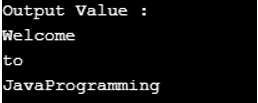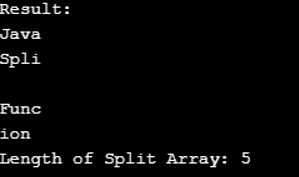split() Function in Java
Java split() function is used to splitting the string into the string array based on the regular expression or the given delimiter. The resultant object is an array containing the split strings. In the resultant returned array, we can pass the limit to the number of elements.
ADVERTISEMENT Popular Course in this category JAVA MASTERY - Specialization | 78 Course Series | 15 Mock TestsLet’s see the example,
- String: Java@SplitFunctions
- Regular Expression: @
- Result: “Java,” “SplitFunctions”
The above example splits the string based on the matches of the required regular expression.
Syntax:
The syntax for the split function is as follows,
public String[] split(String regex)
Here in the above signature, regex is delimiting for the regular expression. It specifies the character which is used for splitting the string. Finally, the resultant return value returns the array of strings which splits the string based on the matches of the regular expression.
How does the split() Function work in Java?
In Java Split() function, we split the string using various methods; the string class makes two methods to split the strings.
Let’s see the available signatures as follows,
- public String[] split(String regex, int limit)
- public String[] split(String regex)
1. public String[] split(String regex)
This method splits the string using the regular expression on the given string; the entire string splits the string, and the resultant return form as an array string. In Java 1.4, the above method is introduced. Let’s see the example for splitting the string and the corresponding resultant output,
Code:
String string_1="JavaProgram";
System.out.println(Arrays.toString(s.split("a")));Output:

2. public String[] split(String regex, int limit)
We use this method when we need to split a Java string into a limited number of strings; for that purpose, we go for this method; let’s see the example for the string which has the string variable containing the name and address with the delimiter as a comma, the following address having the commas in it, so we go for this approach.
Code:
String s = "Spencer Plaza, New York, USA";
String[] data = s.split(",", 2);
System.out.println("Name = "+data[0]); // Spencer Plaza
System.out.println("Address = "+data[1]); //New York,USAThe limit parameter is optional. An integer that indicates the number of splits and the items after the split limit will not be included in the array. The first method above uses the second method by passing the limit as 0.
Code:
public String[] split(String regex) {
return split(regex, 0);
}Examples of split() Function
Examples of the following are given below:
Example #1
Code:
import java.io.*;
public class Program_1
{
public static void main(String args[]) {
String string_1 = new String("Welcome-to-JavaProgramming");
System.out.println("Output Value :" );
for (String res: string_1.split("-"))
{
System.out.println(res);
}
}
}Output:

Using the split() function for the string that needs to provide and divide the separator argument, we were going to use the separator as a comma(,), and the return result will be the array split. The output prints each of the strings called the element of an array after each split operation, as shown below,
Example #2
Code:
import java.io.*;
class Program_2
{
public static void main(String []args)
{
String string_1 = "String, Functions, Split, Methods, Demo";
String[] split_array = string_1.split(", ");
for (int i=0; i < split_array.length; i++)
{
System.out.println(split_array [i]);
}
}
}Output:

Here, we are passing split, which limits as a second argument to this function. This limits the number of split strings.
Example #3
Code:
import java.io.*;
public class Program_3
{
public static void main(String[] args)
{
String string_1 = "JavatSplittFunction";
System.out.println("Result:");
String[] arrSplit = string_1.split("t", 0);
for (String a : arrSplit)
{
System.out.println(a);
}
System.out.println("Length of Split Array: "+ arrSplit.length);
}
}Output:

Split() Method with the limit parameter
The Split() method with the limit parameter splits the strings with limited numbers. The difference between the split() and split() with the limit parameter is that it limits the number of strings returned after split-ups. For the limit, we need to give an input parameter to the split() function. Let’s see the usage of the split() method with the limit parameter,
public String[] split(String regex, int limit)
Here the parameter regex delimits the regular expression, and the limit is for the resulting threshold. The limits are of 3 values, they are:
- limit > 0: If the limit is set as >0, the resultant array length must not be more significant than n, which is applied at most limit-1 times. The last entry contains input with the last matched delimiter.
- limit < 0:If the limit is set as <0, the resultant array with any number of lengths can apply the pattern as many times as possible.
- limit = 0: If the limit is set as equal to 0, the resulting array has any number of lengths, but the empty string will be discarded, and this limit is functional as many times as possible.
This parameter’s return value will be an array of string objects by splitting the given string accords to the limit parameter. The PatternSyntacException will occur if the given regular expression syntax is invalid while executing the code. Let’s see the example program for the split() method on a string with the limit parameter.
Example #4
Code:
public class Program_4 { public static void main(String args[]) { String string_1 = "238-347-9288"; String[] stringArray = string_1.split("8",2); System.out.println("Split() Method with the Limit Parameter"); System.out.println("\nLimit Value is +ve"); System.out.println("Sub-Strings: "+stringArray.length); for(int i=0; i<stringArray.length; i++) { System.out.println("string_1["+i+"] : "+stringArray[i]); } String[] stringArray2 = string_1.split("8",-3); System.out.println("Limit Value is -ve"); System.out.println("Sub-Strings: "+stringArray2.length); for(int i=0; i<stringArray2.length; i++) { System.out.println("string_1["+i+"] : "+stringArray2[i]); } String[] stringArray3 = string_1.split("8",0); System.out.println("Limit Value is 0"); System.out.println("Sub-Strings: "+stringArray3.length); for(int i=0; i<stringArray3.length; i++) { System.out.println("string_1["+i+"] : "+stringArray3[i]); } } }Copy after loginOutput:

The above program shows that the split() method works by the specified limit parameter, as seen by the output:
- The number of substrings in the resulting array is two when the limit is 2.
- Setting the limit to -3 causes the string to split into 4 substrings, including the trailing spaces.
- If you set the limit to 0, it eliminates the trailing spaces. As a result, the input string splits into 2 substrings.
Conclusion
At the end of the ‘Split() Function in Java’ article, we learned how to split strings using the split() method in different Java approaches. I hope in this article; you understand everything that has been shared with examples.
The above is the detailed content of split() Function in Java. For more information, please follow other related articles on the PHP Chinese website!

Hot AI Tools

Undresser.AI Undress
AI-powered app for creating realistic nude photos

AI Clothes Remover
Online AI tool for removing clothes from photos.

Undress AI Tool
Undress images for free

Clothoff.io
AI clothes remover

Video Face Swap
Swap faces in any video effortlessly with our completely free AI face swap tool!

Hot Article

Hot Tools

Notepad++7.3.1
Easy-to-use and free code editor

SublimeText3 Chinese version
Chinese version, very easy to use

Zend Studio 13.0.1
Powerful PHP integrated development environment

Dreamweaver CS6
Visual web development tools

SublimeText3 Mac version
God-level code editing software (SublimeText3)

Hot Topics
 1664
1664
 14
14
 1423
1423
 52
52
 1318
1318
 25
25
 1269
1269
 29
29
 1248
1248
 24
24
 Break or return from Java 8 stream forEach?
Feb 07, 2025 pm 12:09 PM
Break or return from Java 8 stream forEach?
Feb 07, 2025 pm 12:09 PM
Java 8 introduces the Stream API, providing a powerful and expressive way to process data collections. However, a common question when using Stream is: How to break or return from a forEach operation? Traditional loops allow for early interruption or return, but Stream's forEach method does not directly support this method. This article will explain the reasons and explore alternative methods for implementing premature termination in Stream processing systems. Further reading: Java Stream API improvements Understand Stream forEach The forEach method is a terminal operation that performs one operation on each element in the Stream. Its design intention is
 PHP: A Key Language for Web Development
Apr 13, 2025 am 12:08 AM
PHP: A Key Language for Web Development
Apr 13, 2025 am 12:08 AM
PHP is a scripting language widely used on the server side, especially suitable for web development. 1.PHP can embed HTML, process HTTP requests and responses, and supports a variety of databases. 2.PHP is used to generate dynamic web content, process form data, access databases, etc., with strong community support and open source resources. 3. PHP is an interpreted language, and the execution process includes lexical analysis, grammatical analysis, compilation and execution. 4.PHP can be combined with MySQL for advanced applications such as user registration systems. 5. When debugging PHP, you can use functions such as error_reporting() and var_dump(). 6. Optimize PHP code to use caching mechanisms, optimize database queries and use built-in functions. 7
 PHP vs. Python: Understanding the Differences
Apr 11, 2025 am 12:15 AM
PHP vs. Python: Understanding the Differences
Apr 11, 2025 am 12:15 AM
PHP and Python each have their own advantages, and the choice should be based on project requirements. 1.PHP is suitable for web development, with simple syntax and high execution efficiency. 2. Python is suitable for data science and machine learning, with concise syntax and rich libraries.
 PHP vs. Other Languages: A Comparison
Apr 13, 2025 am 12:19 AM
PHP vs. Other Languages: A Comparison
Apr 13, 2025 am 12:19 AM
PHP is suitable for web development, especially in rapid development and processing dynamic content, but is not good at data science and enterprise-level applications. Compared with Python, PHP has more advantages in web development, but is not as good as Python in the field of data science; compared with Java, PHP performs worse in enterprise-level applications, but is more flexible in web development; compared with JavaScript, PHP is more concise in back-end development, but is not as good as JavaScript in front-end development.
 PHP vs. Python: Core Features and Functionality
Apr 13, 2025 am 12:16 AM
PHP vs. Python: Core Features and Functionality
Apr 13, 2025 am 12:16 AM
PHP and Python each have their own advantages and are suitable for different scenarios. 1.PHP is suitable for web development and provides built-in web servers and rich function libraries. 2. Python is suitable for data science and machine learning, with concise syntax and a powerful standard library. When choosing, it should be decided based on project requirements.
 PHP's Impact: Web Development and Beyond
Apr 18, 2025 am 12:10 AM
PHP's Impact: Web Development and Beyond
Apr 18, 2025 am 12:10 AM
PHPhassignificantlyimpactedwebdevelopmentandextendsbeyondit.1)ItpowersmajorplatformslikeWordPressandexcelsindatabaseinteractions.2)PHP'sadaptabilityallowsittoscaleforlargeapplicationsusingframeworkslikeLaravel.3)Beyondweb,PHPisusedincommand-linescrip
 Java Program to Find the Volume of Capsule
Feb 07, 2025 am 11:37 AM
Java Program to Find the Volume of Capsule
Feb 07, 2025 am 11:37 AM
Capsules are three-dimensional geometric figures, composed of a cylinder and a hemisphere at both ends. The volume of the capsule can be calculated by adding the volume of the cylinder and the volume of the hemisphere at both ends. This tutorial will discuss how to calculate the volume of a given capsule in Java using different methods. Capsule volume formula The formula for capsule volume is as follows: Capsule volume = Cylindrical volume Volume Two hemisphere volume in, r: The radius of the hemisphere. h: The height of the cylinder (excluding the hemisphere). Example 1 enter Radius = 5 units Height = 10 units Output Volume = 1570.8 cubic units explain Calculate volume using formula: Volume = π × r2 × h (4
 PHP: The Foundation of Many Websites
Apr 13, 2025 am 12:07 AM
PHP: The Foundation of Many Websites
Apr 13, 2025 am 12:07 AM
The reasons why PHP is the preferred technology stack for many websites include its ease of use, strong community support, and widespread use. 1) Easy to learn and use, suitable for beginners. 2) Have a huge developer community and rich resources. 3) Widely used in WordPress, Drupal and other platforms. 4) Integrate tightly with web servers to simplify development deployment.





